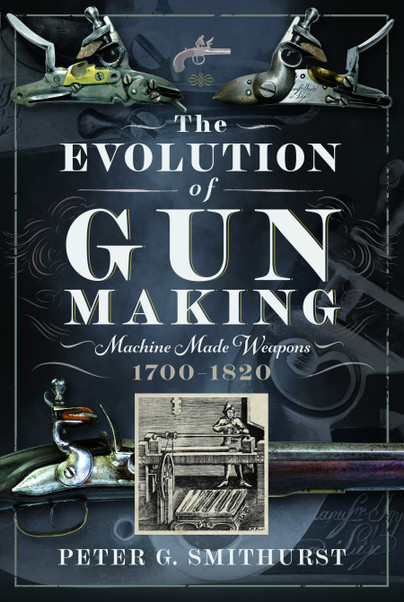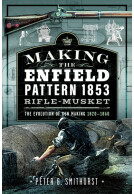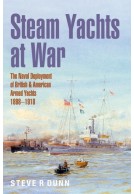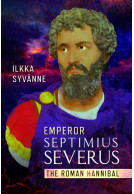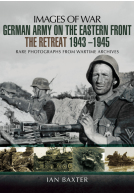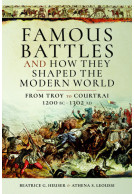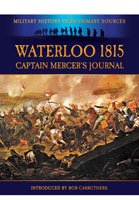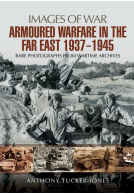The Evolution of Gun Making (Hardback)
Machine made weapons, 1700–1820
Imprint: Pen & Sword Military
Pages: 224
Illustrations: 236 mono illustrations
ISBN: 9781036107789
Published: 8th August 2024
(click here for international delivery rates)
Need a currency converter? Check XE.com for live rates
| Other formats available - Buy the Hardback and get the eBook for £1.99! | Price |
|---|---|
| The Evolution of Gun Making ePub (26.1 MB) Add to Basket | £18.99 |
A variety of factors surround military firearms – they needed to be produced in large numbers to a standardised pattern at an affordable price. This book examines the transition from traditional hand-craft methods to the beginnings of mechanised manufacture using as examples the French Model 1777 and the Russian Model 1808 infantry muskets.
A number of factors led to this choice. The French Model 1777 musket, designed by Honoré Blanc working under General Gribeauval, contained many novel features which became blueprints for the arms of numerous countries and was copied in its entirety by Russia. Another factor is that they are the only firearms whose manufacture is covered in contemporary accounts. A third factor is that they provide contrasts in their methods of manufacture; the French 1777 musket was largely produced by hand-craft methods, whereas in Russia we see the beginnings of extensive mechanisation in the early 19th century.
Another important aspect which appears is ‘interchangeability’ – the ability to exchange identical parts of identical mechanism without ‘special adjustment’. This is a vital factor at the foundation of modern manufacturing and first appears in early 18th century France, was pursued again by Blanc in 1777 and was picked up in Russia.
For the first time, all these ‘technologies’ are examined, explained, compared and contrasted in extensive detail.
"With the benefit of extraordinarily detailed contemporary accounts, the book provides a thorough understanding of how both nations approached arms manufacture in the early decades of the Industrial Revolution."
The American Rifleman
Read the full review here
"This book examines in fascinating and authoritative detail the achievement from around the third quarter of the 18th century of the production of military firearms by machine." 03rd February 2025.
Graeme Rimer FSA, Curator Emeritus, Royal Armouries.
Review as featured in
Arms and Armour
Hihglight: 'if this stuff is your cup of tea, it’s a ‘must have’. It will interest students of gunmaking – this is a key addition to the corpus; gunmakers interested in the origins of their craft; mechanical and manufacturing engineers who perhaps do not appreciate that many of the techniques they have traditionally used arose in gunmaking; and those with an interest in 18th and nineteenth century firearms, especially military firearms,
About Peter G. Smithurst
Peter G Smithurst graduated in Chemistry and Biochemistry in 1968 spending several years as a research chemist before pursuing his passion for industrial and technological history, moving in to museum work.
Peter was appointed Assistant Curator of the Industry and Technology section of Sheffield City Museums in 1975 including the planning and opening of the Kelham Island Industrial Museum in 1982 leading to a promotion to Principal Keeper, Industry and Technology. In 1994 Peter was appointed Assistant Curator of Artillery at the Royal Armouries Museum at Fort Nelson before transferring to the Royal Armouries in Leeds for its opening in 1996.
In 2001, Peter became the Executive Director at the American Precision Museum in Windsor, Vermont housed in the Robbins & Lawrence factory where much of the technology for the mechanised manufacture of firearms, including the Enfield 1853 rifle, had been developed before finally returning to the Royal Armouries in 2002 retiring in 2009 as Senior Curator of Firearms. Just prior to retirement Peter was appointed Visiting Research Fellow at the University of Huddersfield resulting in a PhD from the School of Engineering and Computing in 2020 for a study of the manufacture of the Pattern 1853 Enfield Rifle-Musket and was subsequently elected Fellow of the Society of Antiquaries of London in 2021.







